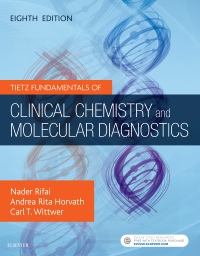
Tietz Fundamentals of Clinical Chemistry and Molecular Diagnostics Elsevier eBook on VitalSource, 8th Edition
Elsevier eBook on VitalSource

Equip students with the foundational knowledge they need to successfully work in a clinical lab with Tietz Fundamentals of Clinical Chemistry and Molecular Diagnostics, 8th Edition. From highly respected clinical chemistry expert Nader Rifai, this condensed, easier-to-understand version of the acclaimed Tietz Textbook of Clinical Chemistry and Molecular Diagnostics uses a laboratory perspective to guide students through selecting and performing diagnostic lab tests and accurately evaluating the results. Fundamental coverage includes laboratory principles, analytical techniques, instrumentation, analytes, pathophysiology, and more. This eighth edition features new clinical cases from The Coakley Collection, new questions from The Deacon’s Challenge of Biochemical Calculations Collection, plus new content throughout the text to ensure your students stay up to date on the latest techniques, instrumentation, and technologies.
Newer Edition Available
Tietz Fundamentals of Clinical Chemistry and Molecular Diagnostics - Elsevier EBook on VitalSource
-
- NEW! Updated content throughout the text keeps students up to date on the latest techniques, instrumentation, and technologies
- NEW! New lead author Nader Rifai lends his expertise as the Director of Clinical Chemistry at Children’s Hospital in Boston, the Editor-in-Chief of the journal Clinical Chemistry, and a Professor of Pathology at Harvard University
- NEW! Clinical Cases from The Coakley Collection use real-life scenarios to demonstrate for students how concepts from the text will come in to play in real life practice
- NEW! Questions from The Deacon’s Challenge of Biochemical Calculations Collection help reinforce concepts and help hone students’ critical thinking skills
- Condensed version of the clinical chemistry "bible" offers the same authoritative and well-presented content in a much more focused and streamlined manner that’s perfect for undergraduate learning
- Coverage of analytical techniques and instrumentation includes optical techniques, electrochemistry, electrophoresis, chromatography, mass spectrometry, enzymology, immunochemical techniques, microchips, automation, and point of care testing
- Updated chapters on molecular diagnostics include the principles of molecular biology, nucleic acid techniques and applications, and genomes and nucleic acid alterations, reflecting the changes in this rapidly evolving field
- Learning objectives, key words, and review questions are included in each chapter to support learning
- More than 500 illustrations plus easy-to-read tables help students better understand and remember key concepts
-
- NEW! Clinical Cases from The Coakley Collection use real-life scenarios to demonstrate how concepts from the text will come in to play in real life practice
- NEW! Questions from The Deacon’s Challenge of Biochemical Calculations Collection help reinforce concepts and help readers’ critical thinking skills
- NEW! Updated content throughout the text keeps readers up to date on the latest techniques, instrumentation, and technologies
- NEW! New lead author Nader Rifai lends his expertise as the Director of Clinical Chemistry at Children’s Hospital in Boston, the Editor-in-Chief of the journal Clinical Chemistry, and a Professor of Pathology at Harvard University
-
PART I: PRINCIPLES OF LABORATORY MEDICINE
1. Clinical Chemistry, Molecular Diagnostics, and Laboratory Medicine
2. Analytical and Clinical Evaluation of Methods
3. Preanalytical Variation
4. Biological Variation
5. Establishment and Use of Reference Values
6. Specimen Collection, Processing, and Other Preanalytical Variables
7. Quality Management
8. Principles of Basic Techniques and Laboratory Safety
PART II: ANALYTICAL TECHNIQUES AND INSTRUMENTATION
9. Optical Techniques
10. Electrochemistry and Chemical Sensors
11. Electrophoresis
12. Chromatography
13. Mass Spectrometry
14. Enzyme and Rate Analyses
15. Immunochemical Techniques
16. Automation
17. Point-of-Care Testing
PART III: ANALYTES
18. Amino Acids, Peptides, and Proteins
19. Serum Enzymes
20. Tumor Markers
21. Kidney Function Tests - Creatinine, GFR, Urea, and Uric Acid
22. Carbohydrates
23. Lipids, Lipoproteins, Apolipoproteins, and Other Cardiac Risk Factors
24. Electrolytes and Blood Gases
25. Hormones
26. Catecholamines and Serotonin
27. Vitaminsand Trace Elements,
28. Hemoglobin, Iron, and Bilirubin
29. Porphyrins and Porphyrias
30. Therapeutic Drug Monitoring
31. Clinical Toxicology
32. ToxicElements
PART IV: PATHOPHYSIOLOGY
33. Diabetes Mellitus
34. Cardiovascular Disease
35. Kidney Disease
36. Physiology and Disorders of Water, Electrolyte, and Acid-Base Metabolism
37. Liver Disease
38. Gastrointestinal and Pancreatic Diseases
39. Disorders of Bone and Mineral Metabolism
40. Disorders of the Pituitary Gland
41. Disorders of the Adrenal Cortex
42. Thyroid Disorders
43. Reproduction-Related Disorders
44. Pregnancy and Prenatal Testing
45. Newborn Screening and Inborn Errors of Metabolism
46. Pharmacogenetics
PART V: MOLECULAR DIAGNOSTICS
47. Molecular Principles
48. Molecular Techniques
49. Molecular Applications
Appendix Reference Information for the Clinical Laboratory


 as described in our
as described in our 